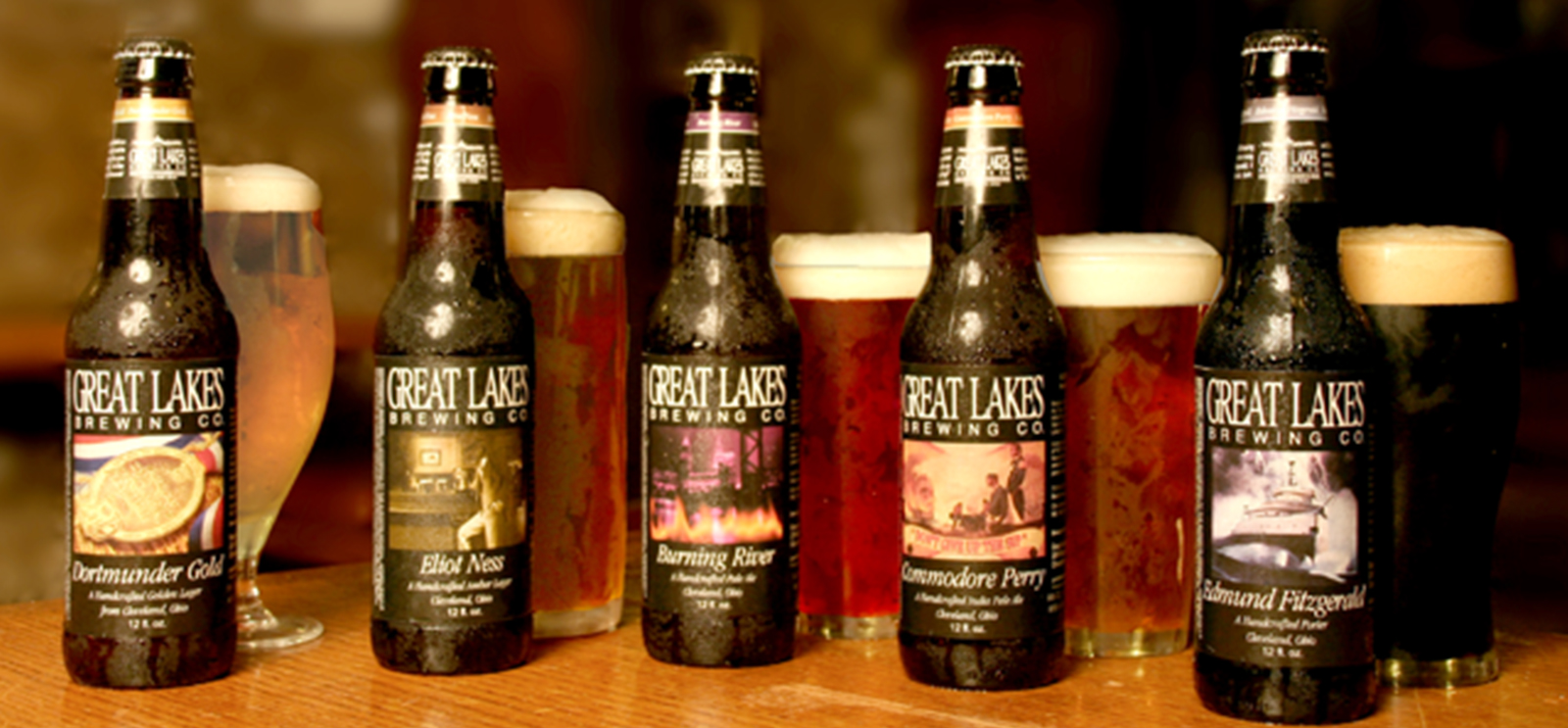
Conway names Great Lakes beers with a nod to Cleveland’s history. (Photo courtesy Great Lakes Brewing Company)
Pat Conway’s (AM’78) fresh approach to craft brewing brings a European sensibility to Cleveland.
Before he could start crafting “big, lusty, full-bodied beers” with Cleveland-centric names like Edmund Fitzgerald Porter and Burning River Pale Ale, Pat Conway, AM’78, had to dig up a few ghosts.
It was the late 1970s, when Americans’ beer preferences tended toward Budweiser and more Budweiser. Conway, who bartended at Jim Sheedy’s on Chicago’s North Side while a social-sciences graduate student at the University, had an inkling that tastes were changing. The traders who patronized the place were drinking imported beers.
Still, American beers had the edge on freshness. “The Germans call beer ‘liquid bread,’” says Conway, the cofounder of Cleveland’s Great Lakes Brewing Company. “The fresher you drink it, the better it is.”
Although Conway wrote his master’s thesis on Karl Jung and Thomas Merton, beer was never far from his mind. “To employ some of Jung’s terms,” he says, “you would say that the craft movement is actually the supple, creative, he would say feminine, side of the brewing industry, and the Budweisers are the very rational, didactic, boring, stale, unimaginative side of brewing.”
He’d learned to distinguish his porters from his stouts during an undergraduate year in Rome. While there, he traveled to Munich and Belgium, spending time in bierstube and public houses. He got the travel itch again during his last year at Chicago. “I submitted my thesis, then left that afternoon with two friends, and we rode a Jeep to Alaska.” In Kodiak, they sold the Jeep to a fisherman and spent a year hopscotching around the world.
Upon his return, Conway took a job as a caseworker at the Circuit Court of Cook County, then as a history and social-studies teacher at Holy Trinity High School in Chicago’s West Town neighborhood. Meanwhile, he was thinking about starting a small brewery specializing in craft beers distributed close to home. In 1986 he and his schoolteacher wife, Jean, moved to Cleveland, where Conway had family and the overhead for new businesses was lower.
His brother, Dan, a bank loan officer, offered to help with his business plan. They launched their operation in 1988 in a boarded-up building on a run-down street that even the owner didn’t see fit to rent. But Pat saw “a neighborhood of red-brick buildings that conjured the romance of brewing days past.” A century earlier, nearly 30 breweries had called Cleveland home, some on these very blocks. Now there were none.
Finding a brewer and equipment proved tougher. The city’s last brewery, Schmidt’s, fermented its farewell batch of hops in 1984. Its final brewer, Thaine Johnson, had retired to the suburbs. Conway tracked him down and talked him into signing on as a consultant.
During the six months it took to build equipment up to Johnson’s standards, Conway immersed himself in the Western Reserve Historical Society’s archives, researching Cleveland’s brewing history, details of which turn up in the décor of the brewpub’s three vintage buildings. An old concrete sign from the Cleveland brewery Schlater’s rests against one wall, salvaged from a nearby construction site; another sepia-tinged display includes a Victorian calendar from McClean’s Feed and Seed Company, which once occupied the beer garden’s space. And Conway likes to tell the story of how Eliot Ness, PhB’25, used to sit and drink at the taproom’s tiger mahogany bar, when it was the Market Tavern and Ness was Cleveland’s embattled safety director.
From the beginning, Great Lakes brewed beer the European way, with malted barley instead of corn and rice. Accolades came quickly. The company’s inaugural beer, the Heisman Dortmunder—named after super-athlete John Heisman, who grew up in the neighborhood and whose father was a “cooper,” or beer barrel maker—won a gold medal at the 1990 Great American Brew Festival. (They changed the name to Dortmunder Gold after the Heisman Trophy folks threatened a lawsuit.) Next came Eliot Ness Amber, and then over the years Burning River Pale Ale, Commodore Perry Indian Pale Ale, Holy Moses White Ale, and dozens more.
Their first year, the Conways produced about 1,000 barrels of beer, hand bottling 30 cases a day, and delivered to beer and wine shops and restaurants out of the trunks of their cars. They grew organically, casting their net to nearby cities, and in 1992 they expanded their operations to a neighboring building.
A decade later, Great Lakes takes up six buildings in Cleveland’s Ohio City neighborhood and employs 160 people. Each year the brewery produces 100,000 barrels of microbrews on German equipment that puts out ten cases a minute. It’s the 22rd largest microbrewery in the country, a size that Conway’s content with for now. “A lot of breweries our size sell to every state in the union,” he says. “We want to sell only in the vicinity of the brewery, so we’re primarily in the Great Lakes region, and all our beers are dated: ‘Please drink by this date.’”
One of Conway’s newest partners is the Oriental Institute; he and OI executive director Steven Camp are developing a line of beers based on early civilizations. They plan to make not only a Sumerian beer, Conway says, “but maybe a Babylonian beer, maybe a Hittite beer, maybe an Egyptian beer.” And going even further, he adds, perhaps also beer from the Middle Ages. “It’s still a work in progress, but the brewers are excited.”
No recipe exists for, say, ancient Sumerian lager, but Conway has OI pictures of figurines that mourners put in royal tombs, “so they would have breweries in the afterlife,” he says. “We know they were brewing beer—you can see the raw materials—but there is no real description of the taste that was involved. It might have been wretched.” Or it might have tasted like the Sumerian version of liquid bread.
